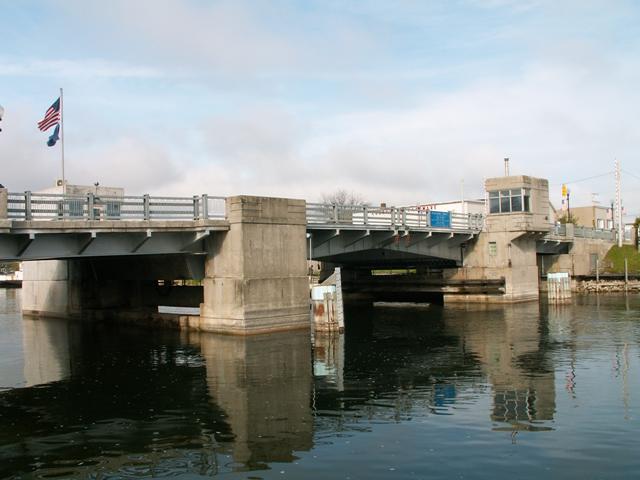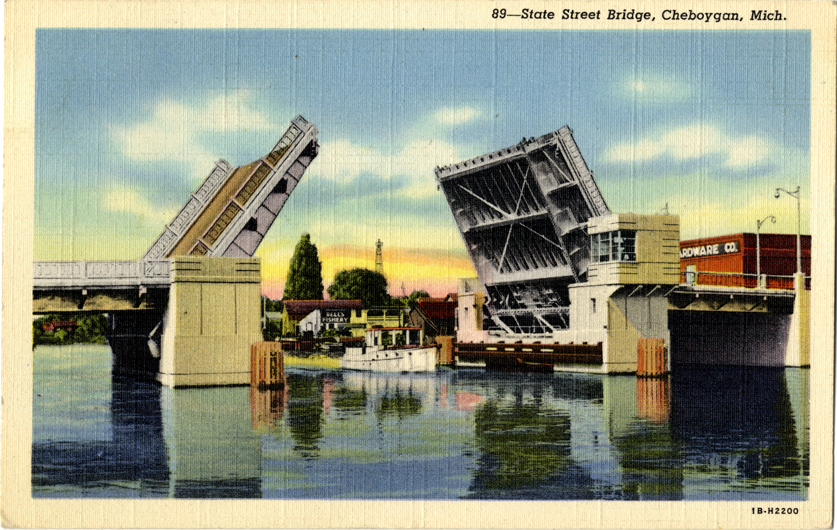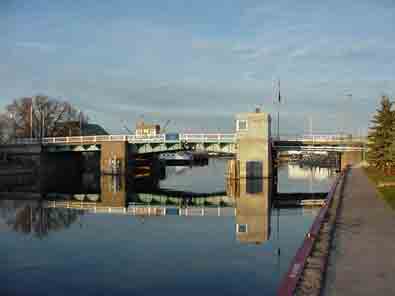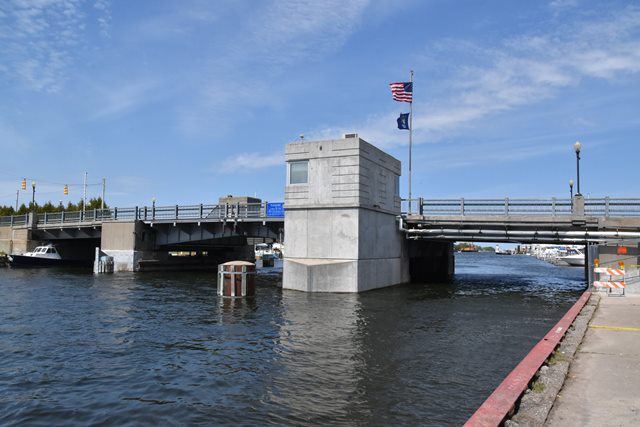We Recommend:
Bach Steel - Experts at historic truss bridge restoration.
BridgeHunter.com Phase 1 is released to the public! - Visit Now
Cheboygan Bridge

Primary Photographer(s): Nathan Holth
Bridge Documented: July 1, 2006, September 6, 2014, and June 3, 2017
Cheboygan: Cheboygan County, Michigan: United States
Metal Variable Depth Deck Girder, Movable: Double Leaf Bascule (Rolling Lift) and Approach Spans: Metal Stringer (Multi-Beam), Fixed
1940 By Builder/Contractor: W. J. Storen Company of Detroit, Michigan and Engineer/Design: Hazelet and Erdal of Chicago, Illinois
2003
70.0 Feet (21.3 Meters)
155.0 Feet (47.2 Meters)
40 Feet (12.19 Meters)
1 Main Span(s) and 2 Approach Span(s)
16116081000B030

View Information About HSR Ratings
Bridge Documentation
View Archived National Bridge Inventory Report - Has Additional Details and Evaluation
View National Register of Historic Places Nomination Form For This Bridge

This is an extremely small bascule bridge. Although the total length is of fair size, the main movable span is quite short for a bascule bridge. Because of its short length, one might expect that such a bridge would be a single-leaf structure, but the Cheboygan bridge is in fact a double-leaf. This bridge also features one steel stringer approach span at each end of the bridge.
This bridge was renovated by MDOT in 2003. MDOT has shown an interest in preserving a few of its bridges, which is noteworthy, as many departments in other states do not make such moves at all. MDOT has a special process they did on this bridge as well as the Belding Bridge to retain the historic railings while also upgrading the railings to meet currently acceptable standards. They used special posts that are similar looking to the original steel posts, but include special mounts for modern steel box railings on the traffic side of the railings. Behind those, they attach the original railing panels. The result is that the original appearance, especially from a riverside view, is still fairly similar. This represents a rare compromise in which both safety and history can coexist, and serves as an example for future preservation projects.

Above: Historical photo of previous bridge.
Above: Historical postcard of current bridge.
Information and Findings From Michigan Historic Bridge InventoryNarrative Description
The Cheboygan Bascule Bridge, located in the county seat of Cheboygan,
carries US-23 over the Cheboygan River. The structure is comprised of
three steel deck girder spans: the center movable span, flanked by two
uniform-depth fixed girders. The structure extends 155 feet - the three
spans are 42 feet, 70 feet, and 42 feet respectively - with a
40-foot-wide roadway. When raised, the bridge provides a 60-foot-wide
river channel for passing water craft. Statement of Significance The Cheboygan Bascule Bridge was the last bascule bridge built in
Michigan before World War II. The Cheboygan Bridge linked the entire
length of Lake Huron from Port Huron to Mackinaw City and served as a
connecting link between shoreline US-23 and mid-state north-south route
US-27. |
This bridge is tagged with the following special condition(s): Unorganized Photos
![]()
Photo Galleries and Videos: Cheboygan Bridge
2006 Bridge Photo-Documentation
A collection of overview and detail photos. This photo gallery contains a combination of Original Size photos and Mobile Optimized photos in a touch-friendly popup viewer.Alternatively, Browse Without Using Viewer
![]()
2017 Additional Unorganized Photos
Original / Full Size PhotosA supplemental collection of photos that are from additional visit(s) to the bridge and have not been organized or captioned. This gallery offers photos in the highest available resolution and file size in a touch-friendly popup viewer.
Alternatively, Browse Without Using Viewer
![]()
2017 Additional Unorganized Photos
Mobile Optimized PhotosA supplemental collection of photos that are from additional visit(s) to the bridge and have not been organized or captioned. This gallery features data-friendly, fast-loading photos in a touch-friendly popup viewer.
Alternatively, Browse Without Using Viewer
![]()
Maps and Links: Cheboygan Bridge
Coordinates (Latitude, Longitude):
Search For Additional Bridge Listings:
Bridgehunter.com: View listed bridges within 0.5 miles (0.8 kilometers) of this bridge.
Bridgehunter.com: View listed bridges within 10 miles (16 kilometers) of this bridge.
Additional Maps:
Google Streetview (If Available)
GeoHack (Additional Links and Coordinates)
Apple Maps (Via DuckDuckGo Search)
Apple Maps (Apple devices only)
Android: Open Location In Your Map or GPS App
Flickr Gallery (Find Nearby Photos)
Wikimedia Commons (Find Nearby Photos)
Directions Via Sygic For Android
Directions Via Sygic For iOS and Android Dolphin Browser
USGS National Map (United States Only)
Historical USGS Topo Maps (United States Only)
Historic Aerials (United States Only)
CalTopo Maps (United States Only)





